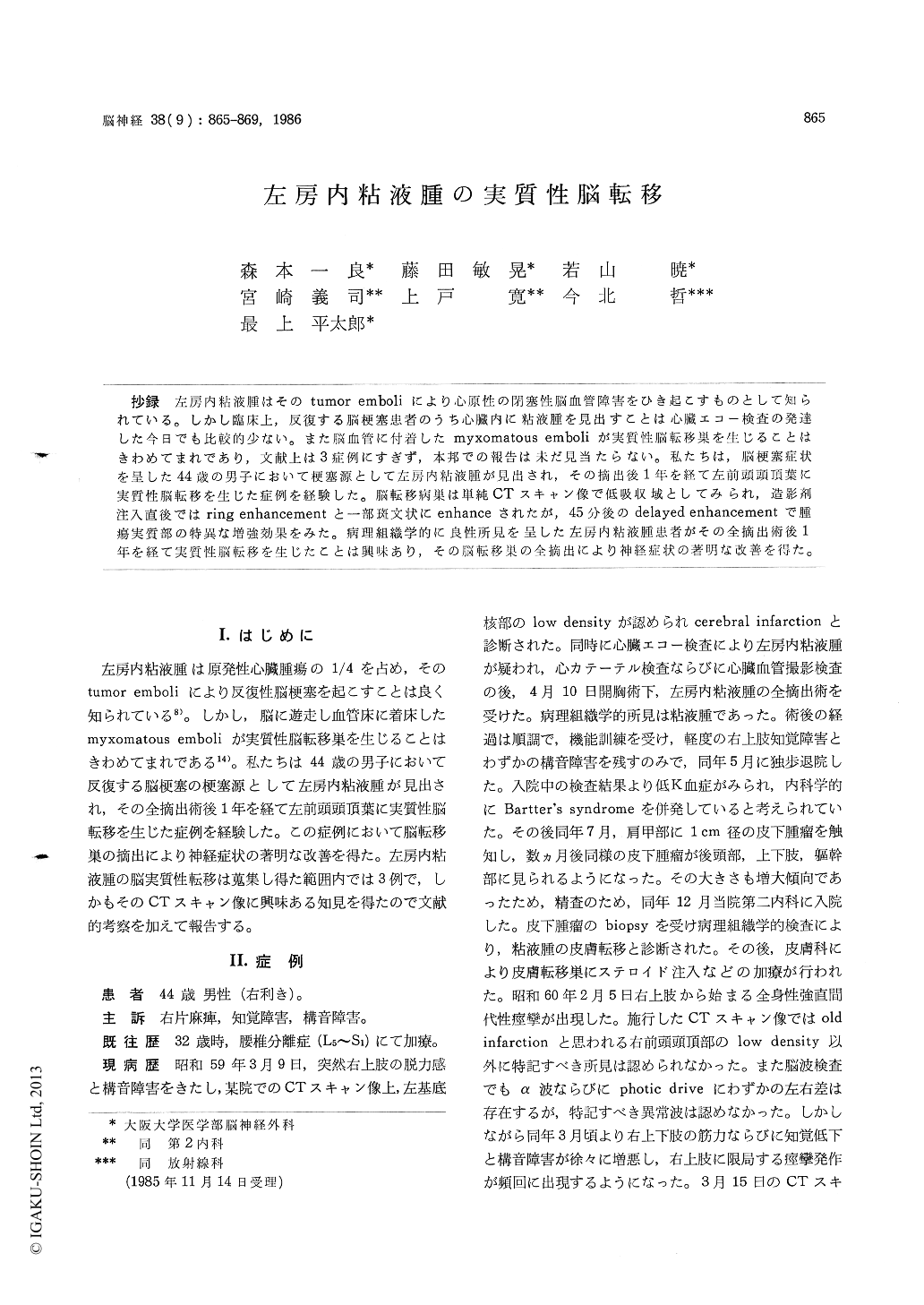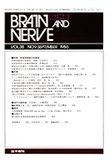Japanese
English
- 有料閲覧
- Abstract 文献概要
- 1ページ目 Look Inside
抄録 左房内粘液腫はそのtumor emboliにより心原性の閉塞性脳血管障害をひき起こすものとして知られている。しかし臨床上,反復する脳梗塞患者のうち心臓内に粘液腫を見出すことは心臓エコー検査の発達した今日でも比較的少ない。また脳血管に付着したmyxomatous emboliが実質性脳転移巣を生じることはきわめてまれであり,文献上は3症例にすぎず,本邦での報告は未だ見当たらない。私たちは,脳梗塞症状を呈した44歳の男子において梗塞源として左房内粘液腫が見出され,その摘出後1年を経て左前頭頭頂葉に実質性脳転移を生じた症例を経験した。脳転移病巣は単純CTスキャン像で低吸収域としてみられ,造影剤注入直後ではring enhancementと一部斑文状にenhanceされたが,45分後のdelayed enhancementで腫瘍実質部の特異な増強効果をみた。病理組織学的に良性所見を呈した左房内粘液腫患者がその全摘出術後1年を経て実質性脳転移を生じたことは興味あり,その脳転移巣の全摘出により神経症状の著明な改善を得た。
A case of cardiac myxoma presenting as meta-static brain tumor are reported. The patient was a 44-year-old man. One year prior to this admis-sion, he had suffered stroke, which was characte-rized by right hemiparesis and dysarthria. The computed tomographic (=CT) scan of the head at that time showed a low density on the left basal ganglia and the echocardiogram suggested a left atrial myxoma. At surgery, a polypoid myxoma attached to the atrial septum was totally removed. Right hemiparesis was improved and the patient was discharged. A few months later, the patient was evaluated for multiple cutaneous masses and diagnosed by biopsy as metastatic myxoma. The patient's condition remained un-changed until this admission. In March 1985, the patient had a tonic-clonic convulsion marching from right hand and developed right hemiplegia with drowsy. An echocardiogram failed to reveal recurrence of the cardiac myxoma. A CT scan revealed a 5-cm, relatively circumscribed, low density mass in the left fronto-parietal lobe, ring mottled enhancement after contrast administration and more enhancement in the delayed scanning of 45 min. Craniotomy showed a tender, friable tumor with a yellowish cyst fluid, but apparently not invading the brain parenchyma. After com-plete excision of the mass, there was rapid lessing in the hemiplegia and improvement in the level of consciousness. A contrast-enhancement CT scan performed 2 weeks after craniotomy revealed no evidence of residual tumor. Pathohistological ex-amination showed spindle-shaped and stellate cells which formed clusters and contained large amounts of acid polysaccharides as demonstrated by the alcian blue method. Histologically, the tissue from all three sites, cardiac myxoma, cutaneous metastasis and brain metastasis, was essentially the same. The microscopic feature of the tissue obtained at craniotomy is diagnostic of a more nuclear pleomorphism than the others. Only three other cases of pathologically confirmed brain metastasis of cardiac myxoma are reported in the literature. An extremely rare circumstance is documented here, metastasis by a cardiac myxoma.

Copyright © 1986, Igaku-Shoin Ltd. All rights reserved.


